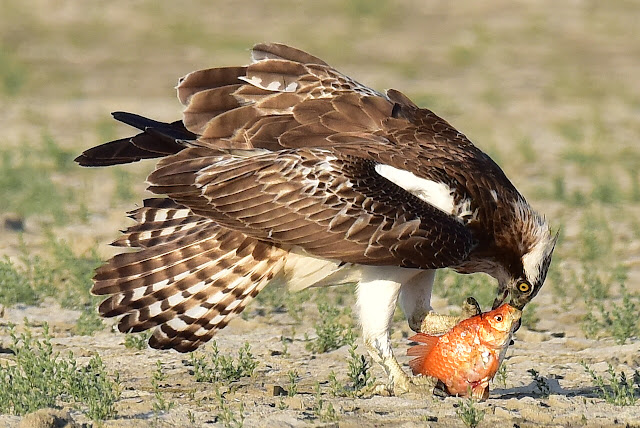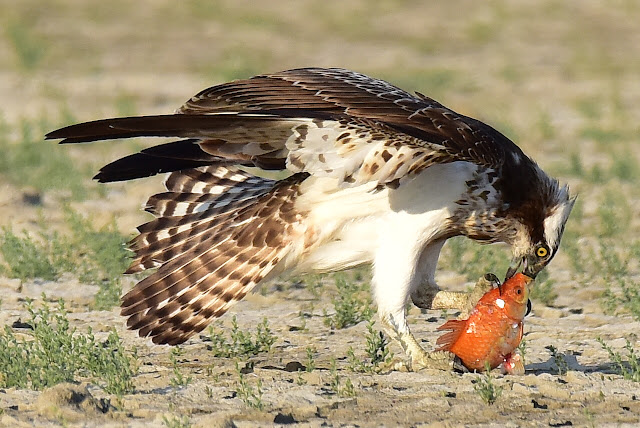See also
List of Cyprus birds of prey on this blog - Λίστα Αρπαχτικών πουλιών της Κύπρου σε αυτό το ιστολόγιο
Cyprus birds of prey - Αρπαχτικά πουλιά της Κύπρου

 The osprey (Pandion haliaetus), sometimes known as the fish eagle, sea hawk, river hawk, or fish hawk, is a diurnal, fish-eating bird of prey. It is a large raptor, reaching more than 60 cm (24 in) in length and 180 cm (71 in) across the wings. It is brown on the upperparts and predominantly greyish on the head and underparts.
The osprey (Pandion haliaetus), sometimes known as the fish eagle, sea hawk, river hawk, or fish hawk, is a diurnal, fish-eating bird of prey. It is a large raptor, reaching more than 60 cm (24 in) in length and 180 cm (71 in) across the wings. It is brown on the upperparts and predominantly greyish on the head and underparts.
 The osprey tolerates a wide variety of habitats, nesting in any location near a body of water providing an adequate food supply. It is found on all continents except Antarctica, although in South America it occurs only as a non-breeding migrant.
The osprey tolerates a wide variety of habitats, nesting in any location near a body of water providing an adequate food supply. It is found on all continents except Antarctica, although in South America it occurs only as a non-breeding migrant.
As its other common names suggest, the osprey's diet consists almost exclusively of fish. It possesses specialised physical characteristics and exhibits unique behaviour to assist in hunting and catching prey. As a result of these unique characteristics, it has been given its owntaxonomic genus, Pandion and family, Pandionidae. Four subspecies are usually recognized, one of which has recently been given full species status (see below). Despite its propensity to nest near water, the osprey is not classed as a sea eagle

 The osprey was one of the many species described by Carl Linnaeus in his 18th-century work, Systema Naturae, and named as Falco haliaeetus. The genus, Pandion, is the sole member of the family of Pandionidae, and used to contain only one species, the osprey (P. haliaetus). The genus Pandion was described by the French zoologist Marie Jules César Savigny in 1809, and is taken from a mythical Greek king, Pandion.
The osprey was one of the many species described by Carl Linnaeus in his 18th-century work, Systema Naturae, and named as Falco haliaeetus. The genus, Pandion, is the sole member of the family of Pandionidae, and used to contain only one species, the osprey (P. haliaetus). The genus Pandion was described by the French zoologist Marie Jules César Savigny in 1809, and is taken from a mythical Greek king, Pandion.
 The osprey differs in several respects from other diurnal birds of prey. Its toes are of equal length, its tarsi are reticulate, and its talons are rounded, rather than grooved. The osprey and owls are the only raptors whose outer toe is reversible, allowing them to grasp their prey with two toes in front and two behind. This is particularly helpful when they grab slippery fish. It has always presented something of a riddle to taxonomists, but here it is treated as the sole living member of the family Pandionidae, and the family listed in its traditional place as part of the order Falconiformes. Other schemes place it alongside the hawks and eagles in the family Accipitridae—which itself can be regarded as making up the bulk of the order Accipitriformes or else be lumped with the Falconidae into Falconiformes. The Sibley-Ahlquist taxonomy has placed it together with the other diurnal raptors in a greatly enlarged Ciconiiformes, but this results in an unnatural paraphyletic classification
The osprey differs in several respects from other diurnal birds of prey. Its toes are of equal length, its tarsi are reticulate, and its talons are rounded, rather than grooved. The osprey and owls are the only raptors whose outer toe is reversible, allowing them to grasp their prey with two toes in front and two behind. This is particularly helpful when they grab slippery fish. It has always presented something of a riddle to taxonomists, but here it is treated as the sole living member of the family Pandionidae, and the family listed in its traditional place as part of the order Falconiformes. Other schemes place it alongside the hawks and eagles in the family Accipitridae—which itself can be regarded as making up the bulk of the order Accipitriformes or else be lumped with the Falconidae into Falconiformes. The Sibley-Ahlquist taxonomy has placed it together with the other diurnal raptors in a greatly enlarged Ciconiiformes, but this results in an unnatural paraphyletic classification
 Fish make up 99% of the osprey's diet. It typically takes fish weighing 150–300 g (5.3–10.6 oz) and about 25–35 cm (9.8–13.8 in) in length, but the weight can range from 50 g (1.8 oz) to 2 kg (4.4 lb). Virtually any type of fish in that size range are taken.
Fish make up 99% of the osprey's diet. It typically takes fish weighing 150–300 g (5.3–10.6 oz) and about 25–35 cm (9.8–13.8 in) in length, but the weight can range from 50 g (1.8 oz) to 2 kg (4.4 lb). Virtually any type of fish in that size range are taken.
Ospreys have vision that is well adapted to detecting underwater objects from the air. Prey is first sighted when the osprey is 10–40 m (33–131 ft) above the water, after which the bird hovers momentarily then plunges feet first into the water.

 The osprey is particularly well adapted to this diet, with reversible outer toes, sharp spicules on the underside of the toes, closable nostrils to keep out water during dives, and backwards-facing scales on the talons which act as barbs to help hold its catch.
The osprey is particularly well adapted to this diet, with reversible outer toes, sharp spicules on the underside of the toes, closable nostrils to keep out water during dives, and backwards-facing scales on the talons which act as barbs to help hold its catch.
Occasionally, the osprey may prey on rodents, rabbits, hares, amphibians, other birds, and small reptiles.From Wikipedia, the free encyclopedia























No comments:
Post a Comment